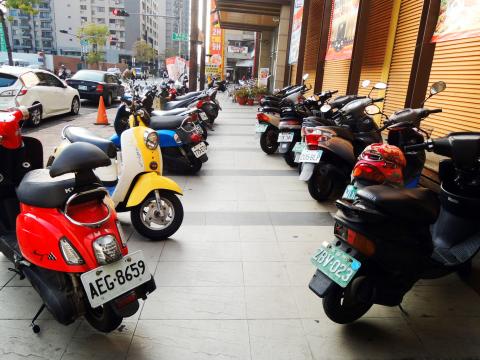Is it true that, starting in April, any scooters will no longer be allowed to be parked on certain sidewalks in Greater Kaohsiung? In response to an angry mob of scooter owners, the Greater Kaohsiung Transportation Bureau says that the initiative will only be carried out initially for sidewalks less than 3m wide. According to statistics, around 4,600 parking spaces for scooters will be removed. As long as safety is not obstructed, parking spaces for scooters on sidewalks at least 3m wide will not be removed, meaning that about 300,000 of such parking spaces will not be affected.
Over the past two years, the bureau has gradually implemented its policy for removing scooters from sidewalks around the municipality’s five main commercial districts and its 20 schools and colleges. This year the bureau will continue giving impetus to the initiative in areas around Greater Kaohsiung’s 14 hospitals and major thoroughfares, working hard to improve scooter parking.
In order to keep scooters from being parked on sidewalks and help guide people to park at roadsides in an orderly fashion, the bureau amended Greater Kaohsiung’s major points for regulating orderly scooter parking in the municipality at the end of January. The bureau then announced that starting on April 1 it will gradually start implementing the new initiative around mass transit and commercial street areas.

Photo: Ke You-hau, Liberty Times
照片:自由時報記者葛祐豪
With an estimated 2.2 million scooters, Greater Kaohsiung has more scooters than any other municipality in the nation. Since word about the initiative got out, a surge of scooter owners expressed disapproval because they assumed it means scooters will be removed from all sidewalks.
The bureau’s Parking Management Center last week explained that if a sidewalk is more than 3m wide or roadside parking does not offer enough space, scooters can still be parked on the sidewalk as long as it does not pose a safety risk. Apart from sections of road with public signage prohibiting parking, scooters will still be allowed to be parked on sidewalks without parking stripes that are located in front of local tenement buildings (qilou) which are managed by the owner. This means that the more than 300,000 parking spaces for scooters located in front of tenement buildings, on sidewalks or roadsides will not be affected by the initiative.
The center says that the initiative, which goes into effect in April, is only for sidewalks that are less than 3m wide. An investigation of scooter-parking supply and demand will also be conducted, the center says, adding that suitable roadside parking spaces will be arranged first, with an estimated 4,600 parking spaces for scooters set to be removed.
(Liberty Times, Translated by Kyle Jeffcoat)
高雄市四月起機車全面退出人行道?機車族罵聲不斷,交通局解釋是先針對寬度未達三公尺的人行道實施,統計約有四千六百格機車格將取消;至於人行道寬度超過三公尺者,在不妨礙安全下,仍可留設機車格,約有三十萬格以上的機車停車空間,暫未受到影響。
交通局這兩年陸續於五大商圈、二十所大專院校周邊,實施機車退出人行道,今年持續在十四所醫院及市區主要幹道周邊推動,有效改善機車停車秩序。
為避免機車亂停在人行道,導引到路邊依序停放,交通局今年一月底修訂「高雄市政府整理機車慢車停放秩序實施要點」,宣布將從四月一日起優先於市區大眾運輸便利、商業路段逐步實施。
高雄市約有兩百二十多萬輛機車,數量居全國第一,消息一出,很多機車族以為機車將全面退出人行道,這段期間反彈聲浪很大。
交通局停管中心上週特別解釋,寬度超過三公尺的人行道,若路邊空間不足,在不妨礙安全下,仍可依規定留設機車格;人行道上若沒有格位,除公告禁停路段外,得停放於騎樓(由所有權人管理),因此市區現有位於騎樓、人行道及道路可停車區域約三十萬格以上的機車停車空間,都暫時未受影響。
停管中心強調,四月起實施機車退出人行道,是指寬度未達三公尺的人行道,將進行供需調查,先於路邊規劃適當停車空間,統計約有四千六百格人行道的機車格會取消。
(自由時報記者葛祐豪)

In an effort to fight phone scams, British mobile phone company O2 has introduced Daisy, an AI designed to engage phone con artists in time-wasting conversations. Daisy is portrayed as a kindly British granny, exploiting scammers’ tendency to target the elderly. Her voice, based on a real grandmother’s for authenticity, adds to her credibility in the role. “O2” has distributed several dedicated phone numbers online to direct scammers to Daisy instead of actual customers. When Daisy receives a call, she translates the scammers’ spoken words into text and then responds to them accordingly through a text-to-speech system. Remarkably, Daisy

Bilingual Story is a fictionalized account. 雙語故事部分內容純屬虛構。 Emma had reviewed 41 resumes that morning. While the ATS screened out 288 unqualified, she screened for AI slop. She could spot it a mile away. She muttered AI buzzwords like curses under her breath. “Team player.” “Results-driven.” “Stakeholder alignment.” “Leveraging core competencies.” Each resume reeked of AI modeling: a cemetery of cliches, tombstones of personality. AI wasn’t just changing hiring. It was draining the humanity from it. Then she found it: a plain PDF cover letter. No template. No design flourishes. The first line read: “I once tried to automate my

Every May 1, Hawaii comes alive with Lei Day, a festival celebrating the rich culture and spirit of the islands. Initiated in 1927 by the poet Don Blanding, Lei Day began as a tribute to the Hawaiian custom of making and wearing leis. The idea was quickly adopted and officially recognized as a holiday in 1929, and leis have since become a symbol of local pride and cultural preservation. In Hawaiian culture, leis are more than decorative garlands made from flowers, shells or feathers. For Hawaiians, giving a lei is as natural as saying “aloha.” It shows love and

1. 他走出門,左右看一下,就過了馬路。 ˇ He walked outside, looked left and right, and crossed the road. χ He walked outside and looked left and right, crossed the road. 註︰並列連接詞 and 在這句中連接三個述語。一般的結構是 x, y, and z。x and y and z 是加強語氣的結構,x and y, z 則不可以。 2. 他們知道自己的弱點以及如何趕上其他競爭者。 ˇ They saw where their weak points lay and how they could catch up with the other competitors. χ They saw where their weak points lay and how to catch up with the other competitors. 註:and 一般連接同等成分,結構相等的單詞、片語或子句。誤句中 and 的前面是子句,後面是不定詞片語,不能用 and 連接,必須把不定詞片語改為子句,and 前後的結構才相等。 3. 她坐上計程車,直接到機場。 ˇ She took a cab, which took her straight to the airport. ˇ She took a cab and it took her straight